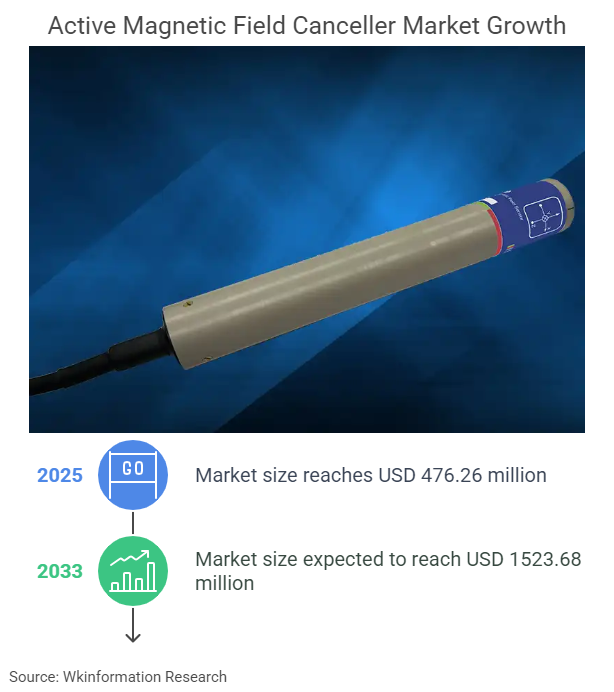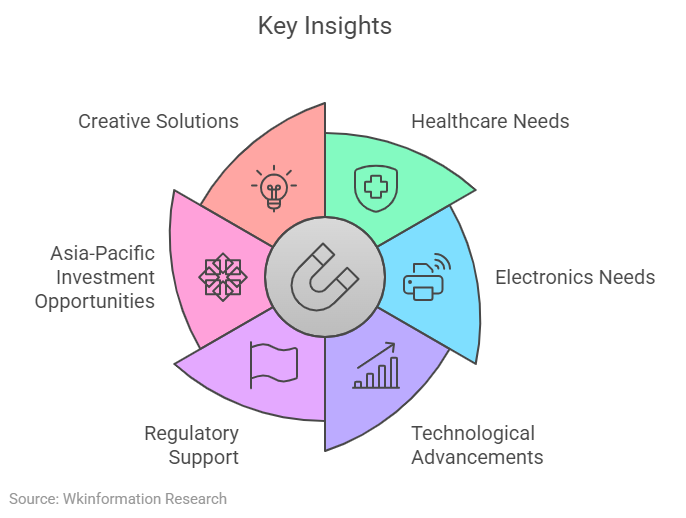
The active magnetic field canceller market is poised for remarkable growth by 2025, driven by technological advancements and increasing demand across various sectors. The market size will reach USD 476.26 million in 2025 and is expected to reach USD 1523.68 million by 2033, with a CAGR of 15.65% from 2025 to 2033. Key trends shaping the market include the adoption of these systems in commercial applications and a focus on miniaturization and cost reduction. Governments worldwide are also supporting this growth through funding and tax incentives, further enhancing the market’s potential. Stakeholders can expect substantial opportunities in this evolving landscape.
Key Insights
- The magnetic field canceller market will grow a lot. It may reach USD 1523.68 million by 2033 due to healthcare and electronics needs.
- New tech like AI and IoT makes these systems better. They are now more useful and easier to use.
- Rules push industries to use these systems. Governments support green tech with rewards.
- Growing markets in Asia-Pacific offer big chances for investment. This is due to fast growth and more healthcare demands.
- Companies should focus on creative solutions for healthcare and industry. This helps them meet the market’s changing needs.

Active Magnetic Field Canceller Market Size and Growth

Current Market Size and Key Statistics
The active magnetic field canceller market has shown significant progress in recent years. The global market size of this industry is projected to reach USD 1523.68 million by 2033. This growth reflects the increasing demand for magnetic field cancelling systems across various sectors.
Key statistics highlight the market’s dynamic nature:
- The global active magnetic field canceller market was valued at an unspecified amount in 2025 and is expected to grow steadily by 2033.
- North America and Asia-Pacific are among the leading regions, with substantial growth anticipated during the forecast period.
- Major manufacturers, including Spicer Consulting and TMC, dominate the market, with the top three vendors accounting for a significant revenue share in 2025.
The US and Canada markets are expected to expand rapidly, driven by advancements in healthcare and electronics. Similarly, the China market is poised for robust growth, supported by technological innovations and increased adoption of magnetic field cancelling systems.
Growth Projections and CAGR for 2025-2033
The global magnetic field cancelling systems market is projected to expand at a compound annual growth rate (CAGR) of 15.65% from 2025 to 2033. This steady growth underscores the rising importance of these systems in mitigating electromagnetic interference (EMI) across industries.
Regions such as North America and Europe are expected to maintain their dominance, while Asia-Pacific emerges as a key player due to its expanding electronics and semiconductor manufacturing sectors. The market size and opportunity analysis reveal that stakeholders can capitalize on this growth by investing in innovative solutions and emerging markets.
Factors Driving Market Expansion
Several factors contribute to the expansion of the global magnetic field cancelling systems market:
- Technological Advancements: Innovations in EMI solutions have enhanced the efficiency and reliability of these systems.
- Rising Demand in Healthcare: The increasing use of magnetic field cancelling systems in medical imaging and diagnostic equipment drives market growth.
- Electronics and Semiconductor Manufacturing: The proliferation of electronic devices and the need for precision in semiconductor production fuel demand.
- Regulatory Compliance: Stringent regulations on EMI emissions encourage industries to adopt advanced magnetic field cancelling systems.
These drivers, combined with the growing awareness of EMI’s impact, create a favorable environment for the market’s sustained growth.
Trends in the Magnetic Field Cancelling Systems Market
Adoption of Portable Magnetic Field Cancelling Systems
The adoption of portable magnetic field cancelling systems is transforming the market landscape. These systems offer flexibility and convenience, making them ideal for industries requiring mobility and adaptability. Recent trends highlight significant advancements in product development. For instance, automation and AI integration have enhanced the efficiency and functionality of these systems. Companies are leveraging material innovations to create cost-effective and sustainable solutions that meet diverse industry needs.
Key trends shaping this segment include:
- Integration of AI and IoT, enabling real-time monitoring and predictive maintenance.
- A growing focus on sustainability, with manufacturers prioritizing recyclable materials and energy-efficient processes.
- Expansion into emerging markets like Asia-Pacific and Africa, where tailored solutions address local demands.
These developments position portable systems as a vital component of the active magnetic field canceller market, driving growth and adoption globally.
Technological Advancements in EMI Solutions
Technological advancements in electromagnetic interference (EMI) solutions are revolutionizing the magnetic field cancelling systems market. Innovations have significantly improved product capabilities, enhancing efficiency and reducing costs. Automation and smart systems are reshaping the industry, enabling manufacturers to deliver high-performance solutions at competitive prices.
These advancements have led to increased adoption across sectors such as healthcare, electronics, and semiconductor manufacturing. By addressing the challenges of EMI, these solutions ensure precision and reliability in critical applications. As a result, the market continues to expand, fueled by the demand for cutting-edge technologies.
Regulatory Compliance and Its Impact on Market Growth
Regulatory compliance plays a pivotal role in shaping the growth of the magnetic field cancelling systems market. Governments worldwide are implementing policies that promote sustainability and eco-friendly technologies. For example, Europe has seen increased demand for environmentally conscious solutions due to stringent regulations. Countries like Germany and the UK lead in adopting innovative systems, supported by favorable regulatory frameworks.
Key factors driving this trend include:
- Incentives encouraging investment in green technologies.
- Policies that prioritize sustainability, boosting demand for efficient solutions.
These regulations not only foster innovation but also create a competitive advantage for companies aligning with global standards. As a result, regulatory compliance remains a critical driver of market expansion.
Drivers and Challenges in the Global Magnetic Field Cancelling Systems Market
Key Drivers
Rising Demand in Healthcare and Electronics
The healthcare and electronics industries are driving the growth of the global magnetic field cancelling systems market. In healthcare, the increasing use of advanced imaging technologies, such as MRI and CT scans, has created a significant demand for magnetic field cancelling systems. These systems ensure the accuracy and reliability of diagnostic equipment by mitigating electromagnetic interference. Similarly, the electronics sector has witnessed a surge in demand due to the proliferation of consumer devices and the need for precision in semiconductor manufacturing. The active magnetic field canceller market benefits from these trends, as industries prioritize solutions that enhance operational efficiency and product quality.
Increasing Prevalence of Electronic Devices
The rapid adoption of electronic devices worldwide has amplified the demand for magnetic field cancelling systems. Smartphones, laptops, and other consumer electronics generate electromagnetic interference, which can disrupt sensitive equipment. To address this challenge, industries are investing in advanced solutions that ensure seamless device performance. The ongoing digital transformation across sectors further accelerates this demand, as businesses adopt technologies that rely on electromagnetic stability. Material innovations and automation have also contributed to the evolution of these systems, catering to the diverse needs of industries.
Major Challenges
High Implementation Costs
Despite its growth potential, the global magnetic field cancelling systems market faces challenges related to high implementation costs. Developing and deploying these systems require significant investment in research, materials, and skilled labor. Small and medium-sized enterprises often struggle to adopt these solutions due to budget constraints. Additionally, the cost of maintaining and upgrading these systems adds to the financial burden, limiting their widespread adoption. Companies must focus on cost-effective innovations to overcome this barrier and expand their market reach.
Technical and Maintenance Barriers
Technical complexities and maintenance requirements pose significant challenges to the magnetic field cancelling systems market. Rapidly evolving technologies demand continuous innovation, which can strain resources and expertise. Furthermore, industries often face difficulties in maintaining these systems, as they require specialized knowledge and tools. A lack of awareness about the benefits of magnetic field cancelling systems exacerbates this issue, particularly in emerging markets. Addressing these barriers is crucial for sustaining growth and meeting the changing demands of consumers.
Market Segmentation of Active Magnetic Field Canceller Market
By Type
Active Shielding Systems
Active shielding systems play a crucial role in the magnetic field cancelling systems market. These systems detect external magnetic fields and counteract them by generating opposing fields. They are further divided into two categories:
- Single-axis Systems: These systems focus on canceling magnetic fields in one direction, making them suitable for specific applications requiring targeted interference mitigation.
- Multi-axis Systems: These systems handle magnetic fields in multiple directions, offering comprehensive protection for environments with complex interference patterns.
The versatility and precision of active shielding systems make them a preferred choice in industries like healthcare and electronics.
Passive Shielding Systems
Passive shielding systems provide a simpler and cost-effective alternative. These systems use materials with high magnetic permeability to block external magnetic fields. Their straightforward design and lower implementation costs make them ideal for applications where budget constraints exist. Passive systems are particularly popular in industrial and research settings due to their reliability and ease of maintenance.
By Application
Healthcare and Medical Imaging
Healthcare represents one of the key applications of magnetic field cancelling systems. These systems are essential in medical imaging technologies like MRI and CT scans, where electromagnetic interference can compromise diagnostic accuracy. The growing demand for advanced imaging solutions drives the adoption of these systems in healthcare facilities worldwide.
Electronics and Semiconductor Manufacturing
The electronics sector heavily relies on magnetic field cancelling systems to ensure precision in semiconductor manufacturing. These systems mitigate interference caused by the proliferation of electronic devices, enabling manufacturers to maintain high-quality standards. The increasing demand for consumer electronics further accelerates the growth of this application segment.
Research and Development
Research and development activities benefit significantly from magnetic field cancelling systems. Laboratories and research institutions use these systems to create controlled environments for experiments and testing. Their ability to eliminate interference ensures reliable and reproducible results, making them indispensable in scientific advancements.
By Region
| Region | Growth Factors |
|---|---|
| North America | High concentration of advanced healthcare facilities, research institutions, and industrial automation. |
| Europe | Driven by stringent EMC regulations and significant investments in cutting-edge technologies. |
| Asia-Pacific | Anticipated highest growth rate due to rapid industrialization, increasing healthcare investments, and booming consumer electronics market. |
| Latin America | Expected to grow steadily as awareness and adoption of magnetic field cancellers increase. |
| Middle East & Africa | Smaller markets but projected to grow steadily with increasing awareness and adoption. |
North America and Europe dominate the market due to their advanced infrastructure and regulatory frameworks. However, Asia-Pacific is emerging as a key player, driven by industrialization and growing investments in healthcare and electronics. Latin America and the Middle East & Africa show steady growth potential as awareness of magnetic field cancelling systems increases.
Competitive Landscape of the Global Magnetic Field Cancelling Systems Market
Key Players and Market Share
The global magnetic field cancelling systems market features several prominent players who drive innovation and competition. These companies have established themselves as leaders by offering advanced solutions tailored to diverse industry needs.
- Spicer Consulting: Known for its cutting-edge technology, Spicer Consulting has a strong presence in the market. Its products cater to healthcare, electronics, and research sectors.
- Stefan Mayer Instruments: This company specializes in high-precision magnetic field cancelling systems, particularly for scientific and industrial applications.
- Agar Scientific: Agar Scientific focuses on providing reliable solutions for research and development, ensuring accuracy in experimental environments.
- Ohtama: Ohtama has gained recognition for its innovative designs and cost-effective systems, making it a preferred choice in emerging markets.
- Beijing Eusci Earth Technologies: This company has expanded its footprint by offering advanced systems that address the growing demand in Asia-Pacific.
Other notable players include TMC, EMF Services LLC, Tokkyokiki Corporation, Mishima Kosan, and hatplant.com. These companies contribute to the market’s dynamic nature by introducing new technologies and expanding their global reach.
Strategies of Leading Companies
Product Innovation and Development
Leading companies prioritize product innovation to maintain their competitive edge. They invest heavily in research and development to create systems with enhanced efficiency and reliability. For example, advancements in automation and AI integration have enabled manufacturers to offer smarter magnetic field cancelling systems. These innovations address the evolving needs of industries such as healthcare and electronics, ensuring sustained market growth.
Strategic Partnerships and Collaborations
Collaborations play a crucial role in the strategies of top companies. By partnering with research institutions and technology providers, these firms accelerate the development of advanced solutions. Strategic alliances also help companies expand their customer base and enter new markets. For instance, partnerships in the Asia-Pacific region have enabled firms to tap into the growing demand for magnetic field cancelling systems in emerging economies.
Expansion into Emerging Markets
Emerging markets present significant growth opportunities for the magnetic field cancelling systems market. Companies are focusing on regions like Asia-Pacific, Latin America, and Africa to capitalize on increasing industrialization and healthcare investments. By tailoring their products to meet local demands, these firms enhance their market presence and drive adoption in these regions.
Technological Advancements in Magnetic Field Cancelling Systems

Innovations in Magnetic Field Cancellation Technology
Recent innovations have significantly enhanced the capabilities of magnetic field cancelling systems. Dedicated systems now actively eliminate external magnetic fields, improving the performance of high-resolution imaging tools like electron microscopes. For instance, a dual magnetic cancelling system is being utilized at Hubei University in China for atomic-level studies of ferroelectric materials. These advancements demonstrate the growing importance of precision in scientific research.
Automation and smart systems are also transforming the market. Manufacturers are leveraging these technologies to develop advanced solutions that address the increasing complexity of electromagnetic interference. By integrating automation, companies can deliver systems that are not only efficient but also cost-effective, making them accessible to a broader range of industries.
Integration with IoT and AI for Enhanced Performance
The integration of IoT and AI has revolutionized the functionality of magnetic field cancelling systems. These technologies enable real-time monitoring and predictive maintenance, significantly improving operational efficiency. For industrial applications, this integration ensures uninterrupted performance by identifying potential issues before they escalate. In consumer applications, it enhances user experience by providing seamless and reliable operation.
This combination of IoT and AI highlights the versatility of magnetic field cancelling systems. By offering solutions that adapt to diverse needs, manufacturers are driving the market forward. The ability to monitor systems remotely and optimize performance in real time has become a critical factor in the adoption of these technologies.
Emerging Trends in Research and Development
Research and development in magnetic field cancelling systems are focusing on three key areas. First, the integration of AI and IoT continues to enhance operational efficiency and enable real-time monitoring. Second, there is a growing emphasis on sustainability, with manufacturers prioritizing eco-friendly products and processes. This shift reflects the market’s commitment to green technologies.
Finally, manufacturers are expanding into emerging markets such as Asia-Pacific and Africa. By tailoring their offerings to meet local demands, companies are tapping into high-growth regions. These trends underscore the dynamic nature of the market and its potential for future innovation.
Investment Opportunities and Future Prospects in the Active Magnetic Field Canceller Market
Key Investment Areas
Emerging Markets in Asia-Pacific
The Asia-Pacific region offers significant opportunities for investment in magnetic field cancelling systems. Rapid industrialization and increasing healthcare investments drive demand in countries like China, India, and Japan. The region’s booming electronics sector further amplifies the need for these systems, particularly in semiconductor manufacturing. Emerging markets in Asia-Pacific also benefit from tailored solutions that address local challenges, making them attractive for stakeholders seeking growth.
Key areas for investment include:
- Healthcare facilities requiring advanced imaging technologies.
- Industrial applications demanding precision and reliability.
- Research laboratories focusing on controlled environments.
- Advancements in technology, including IoT and AI integration.
Advancements in Healthcare Applications
Healthcare remains a critical sector for magnetic field cancelling systems. The growing adoption of MRI and CT scans necessitates solutions that mitigate electromagnetic interference. Hospitals and diagnostic centers worldwide are investing in these systems to enhance imaging accuracy. Innovations in medical technology, such as portable imaging devices, further expand the scope of applications. Stakeholders can capitalize on this trend by developing cost-effective and efficient solutions tailored to healthcare needs.
Future Market Outlook
Growth Potential in Key Regions
The global market for magnetic field cancelling systems shows promising growth across various regions. North America and Europe dominate due to advanced healthcare infrastructure and stringent regulations. Asia-Pacific emerges as the fastest-growing region, driven by industrialization and healthcare investments. Latin America and the Middle East & Africa, though smaller markets, exhibit steady growth as awareness increases.
Long-term Opportunities for Stakeholders
The active magnetic field canceller market offers long-term opportunities for stakeholders. Rising demand in emerging markets and the growing adoption of these systems in new applications drive expansion. Increased investment in research and development fosters innovation, ensuring sustained growth. The market is projected to grow at a compound annual growth rate (CAGR) of 15.65% from 2025 to 2033, highlighting its potential for profitability.
Key opportunities include:
- Expanding into high-growth regions like Asia-Pacific and Africa.
- Developing innovative solutions for healthcare and industrial applications.
- Leveraging advancements in technology to enhance product performance.
Stakeholders who align their strategies with these trends can secure a competitive edge in this evolving market.
Overview
The magnetic field cancelling systems market demonstrates immense growth potential, driven by technological advancements and increasing demand across industries. Key trends, such as the integration of IoT and AI, highlight the transformative impact of innovation on this market. Strategic investments in emerging regions and healthcare applications further enhance its prospects.
Technological progress continues to refine magnetic field cancelling systems, ensuring precision and efficiency in critical applications. Stakeholders who align with these advancements and invest in high-growth areas can secure long-term success. The market’s dynamic nature promises a wealth of opportunities for industries and investors alike.
| Report Metric | Details |
|---|---|
| Report Name | Global Active Magnetic Field Canceller Market Report |
| Base Year | 2024 |
| Segment by Type | · Active Shielding Systems
· Passive Shielding Systems |
| Segment by Application | · Healthcare and Medical Imaging
· Electronics and Semiconductor Manufacturing · Research and Development |
| Geographies Covered | · North America (United States, Canada)
· Europe (Germany, France, UK, Italy, Russia) · Asia-Pacific (China, Japan, South Korea, Taiwan) · Southeast Asia (India) · Latin America (Mexico, Brazil) |
| Forecast units | USD million in value |
| Report coverage | Revenue and volume forecast, company share, competitive landscape, growth factors and trends |
FAQ
What are magnetic field cancelling systems, and why are they important?
Magnetic field cancelling systems eliminate unwanted magnetic interference, ensuring the accuracy of sensitive equipment. These systems are crucial in industries like healthcare and electronics, where precision is essential for operations such as medical imaging and semiconductor manufacturing.
Which industries benefit the most from magnetic field cancelling systems?
Healthcare, electronics, and research sectors benefit significantly. In healthcare, these systems enhance the accuracy of MRI and CT scans. Electronics manufacturers rely on them to maintain precision in semiconductor production. Research institutions use them to create controlled environments for experiments.
What factors are driving the growth of the magnetic field cancelling systems market?
Technological advancements, rising demand in healthcare, and the proliferation of electronic devices drive market growth. Additionally, regulatory compliance and the need for precision in industrial applications contribute to the increasing adoption of these systems globally.
Are there challenges in adopting magnetic field cancelling systems?
High implementation costs and technical complexities pose challenges. Small businesses often face budget constraints, while maintaining these systems requires specialized expertise. Addressing these barriers is essential for broader adoption across industries.
What regions show the highest growth potential in the market?
Asia-Pacific demonstrates the highest growth potential due to rapid industrialization and healthcare investments. North America and Europe maintain dominance with advanced infrastructure and regulatory frameworks. Emerging markets in Latin America and Africa also exhibit steady growth.
Global Active Magnetic Field Canceller Market Report – Table of Contents
1 Market Study Overview
2 Basic Product Information
3 Market Analysis
4 Active Magnetic Field Canceller Related Market Analysis
5 Global Trend Summary
6 Competition by Manufacturer
7 Analysis of Key Players
8 Global Active Magnetic Field Canceller Revenue, Sales Categorized by Regions
9 North America Active Magnetic Field Canceller Market Size Categorized by Countries
10 Europe Active Magnetic Field Canceller Market Size Categorized by Countries
11 Asia-pacific Active Magnetic Field Canceller Market Size Categorized by Countries
12 South America Active Magnetic Field Canceller Market Size Categorized by Countries
13 Middle East and Africa Active Magnetic Field Canceller Market Size Categorized by Countries
14 Global Active Magnetic Field Canceller Industry Segment Analysis
15 Global Active Magnetic Field Canceller Market Forecast
16 Research Findings and Conclusion
17 Appendix



